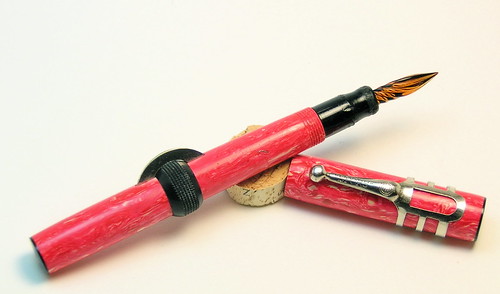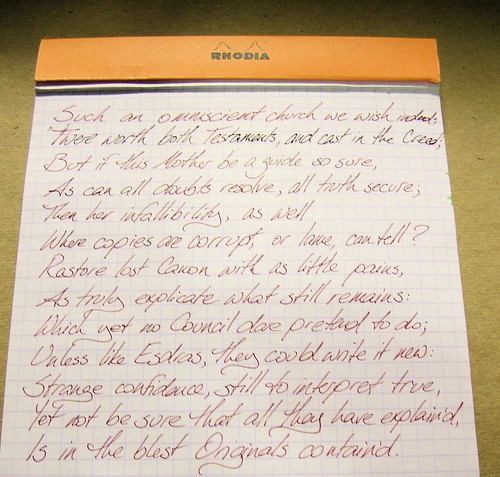Spors Unbound
After considerable strain (resulting in some damage to the section), I finally wrenched open my Spors glass-nibbed fountain pen a while back. Only Sunday, however, did I obtain an ink sac suitable (I used a 12mm sac) for the very narrow portion of the section to which the sac is glued. Since the thin-shelled barrel is a cavernous void, I would guess that Spors originally equipped this pen with a sac that was wider in the body, but with a narrow neck. It doesn’t make much difference to me, because I don’t anticipate ever needing more than a modest amount of ink in this pen.
The photo doesn’t adequately represent the intense pinkness of this pen. It’s hard for me to believe that Spors found buyers for so outrageous a shade in the 1920’s or 30’s; this pen would look much more at home in 1968 than 1930. I’ll be waiting for an opportunity to wear it in public.
Writing with a glass nib differs less dramatically from regular-nib writing than I expected. Pen users refer to nibs that bend noticeably as flexy (at the extreme, as a “wet noodle”); their rigid antithesis is called a nail. As the term suggests, firm nibs really do approach the rigidity of the glass point that the Spors offers. I wrote a sample page with the Spors, and it wasn’t at all uncomfortable (even if it’s hard to dispel the apprehension that at any moment one might break the point of one’s pen).
The point is fine, and the flow is not quite predictable (pause for a few seconds, and you get a heavier flow till the acculumated ink drains off), but it’s a very striking functional curiosity.
Now, yesterday the mail brought a tortoise-shell Sheaffer Balance with a smooth italic nib. Unfortunately for me, it wasn’t a lever-filler (which I could refurb) but a vacuum-fill (which exceeds my competence). I’m very eager to get that one spruced up, though, for it’s exactly the feel of the sort of italic-nibbed pens I’m used to.


